
Real Guns™ is a type 7 FFL holder. These days, whenever we put a gun together, it ends up being big and noisy and weighs twelve pounds. Sure, there is always the entertainment value of blanketing the nearby hills with a pressure wave of rolling thunder, but none of this hardware is appropriate for vegetable garden pest control or taking out critters that are attempting to make a winter home under the equipment shed. I was watching just such a fur ball marauder, sitting in a row of our carrots, going all Bugs Bunny on us, when I got the idea that we needed an air rifle.
I’m one of those guys who likes firearms to have an appearance consistent with their purpose. Subsequently, my deer rifles have bolts and walnut stocks and my defensive rifles are AR 15 types. So when it came time to select an air rifle for the purposes defined, something more traditional in appearance seemed appropriate. It also seemed reasonable to select a gun that used inexpensive and readily available pellets and did not need specialized equipment or process to keep it charged with propellant. After some research, and after trying several manufacturers’ guns, I selected a .177 caliber Benjamin Discovery rifle and high pressure hand pump.
Located in Bloomfield NY, Crosman manufactures and markets air rifles and pistols under the brand names: Benjamin, Crosman, Marlin, Remington, and Sheridan. While ownership has changed over the years, the Crosman company has manufacture red air rifles since 1924. The current product lines are populated with traditional and very modern air rifles and pistols that range in MSRP from $34 for the very basic, to $1,500 for the more exotic. The Discovery rifle is one of their more moderately priced products.
Despite the large selection, choosing a specific gun isn’t difficult. The Crosman site’s MatchMaker function prompts with leading questions regarding price, performance and application criteria then renders a list of applicable and models. Products are also classified by types: PCP (Pre-charged Pneumatic), break barrel, CO2 rifles, variable pump rifles, and pistols. Each model is listed with recommended applications: target shooting, pest control and small game, varmint and/or predator hunting.
Crosman does a credible job of making application recommendations based upon a gun’s ballistic performance. No inappropriate match up between gun and game. No .177 PCP guns recommended for lion hunting, domestic or otherwise. Where they do list an air rifle for larger predators; coyote, bobcat and hogs up to 200 lbs, the recommended rifle is a .357 caliber repeater that launches a 145 grain Nosler bullets with 4,500 PSI of air pressure.
Overview and general operation…
|
||||||||||||||||||||||||||||||||||||||||||
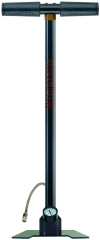 The Benjamin Discovery .177 caliber rifle is available as a stand alone air rifle or as part of a kit that includes a high pressure hand pump. The pump is universal for this purpose and works with all PCP air rifles offered by Crosman. So if a times comes when a .22 or .25 caliber rifles is purchased, the same pump will service all. The pump can also be purchased independent of an air rifle for approximately $200, and can be used with many other brands of air rifles.
The Benjamin Discovery .177 caliber rifle is available as a stand alone air rifle or as part of a kit that includes a high pressure hand pump. The pump is universal for this purpose and works with all PCP air rifles offered by Crosman. So if a times comes when a .22 or .25 caliber rifles is purchased, the same pump will service all. The pump can also be purchased independent of an air rifle for approximately $200, and can be used with many other brands of air rifles.
This Discovery rifle has a maximum operating pressure of 2,000 PSI, which is well within the supplied pumps 3,600 PSI operating capacity. The gun is dual fuel capable and may also be charged to lower power levels with a CO2 cartridge. Use of cartridges requires the purchase of a $47 adapter and, of course, the purchase of cartridges. As noted later, the number of shots that can be fired with one pump fill, and ease of use, caused me to believe the pump was the preferred propellant source.
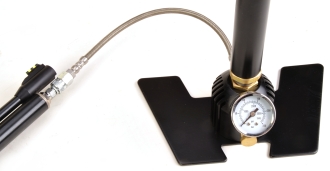 The pump connects to the fill adapter at the front of the rifle that is stowed beneath a trim cap when not is use. The pump’s quick disconnect coupling is easy to attach and disconnect. A pressure bleed valve on the pump is opened after the gun has been filled, and just before the quick disconnect coupling is released, to depressurize the fill line. The pump and bleed valve cannot be used to depressurize the gun.
The pump connects to the fill adapter at the front of the rifle that is stowed beneath a trim cap when not is use. The pump’s quick disconnect coupling is easy to attach and disconnect. A pressure bleed valve on the pump is opened after the gun has been filled, and just before the quick disconnect coupling is released, to depressurize the fill line. The pump and bleed valve cannot be used to depressurize the gun.
The V base can be mounted wide to the rear or front. I found that mounted as pictured, I was positioned directly over the pump handle and I could use my weight, rather than my extended back, to provide the bulk of the pumping effort. Important if you are like me and one hundred and six years old. Starting on empty, it took approximately 95 strokes to fully charge the gun. It was a good workout, but not extraordinary, and filling from 1,250 PSI, the gun pressure point where velocity begins to drop off, took only 35 to 40 strokes to recharge to 2,000 PSI.
.
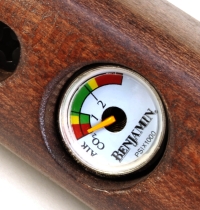
A gauge embedded in the rifle’s forearm tracks pressure. As indicated by the gauge, CO2 operation tops at 1,000 PSI. It took on the average forty five shots for a charge to drop from 2,000 PSI to 1,000 PSI. Velocity drop after a pump fill, associated with lower pressure, began to gradually show below 1,250 PSI, but pressure can fall just below 1,000 PSI before charging is required for proper operation.
A valve meters propellant air volume, so there is no direct correlation between pressure and pellet velocity, which means more uniform shot to shot performance. A hammer spring actuates the gun’s striker with uniform force. Stored pressure against the other side of the valve varies. The higher the stored pressure, the more limited the striker’s travel. As pressure declines, striker travel increases. As a result, the valve meters uniform volumes of propellant by adjusting its response to the striker. Recorded over a chronograph, the progression of velocity decline looks like this:
|
||||||||||||||||||||||||||||||||||||||||||||||||||||||||||||||||||||||||
I’d attribute the first four or five shots to the absence of break-in leading and subsequent increase in friction as they are notably higher than the rest of the population and this higher velocity did not repeat in subsequent sets of collected data.
Let’s define velocity decline as the point where no shot’s velocity is significantly higher than any preceding shots. That point was reached at shot #23, however, the decline remained gradual and the rifle remained fully operational through shot #45. Small game or pest hunting might benefit from recharging the gun at thirty shots to assure maximum power but, for target practice and plinking, shooting until pressure drops below 1,000 PSI is OK.
Construction

The Benjamin Discovery’s receiver is steel and the bolt actuates not unlike a .22 rimfire rifle; lifted and pulled reward to cock the trigger, pushed forward, down and locked to chamber a pellet. Unlike a spring – piston air rifle where a pellet needs to be in place to dampen the force of its spring loaded piston, the Discovery can be degassed by dry firing.
Lots of products look good on the outside, few look as good when the stock is removed. I believe this one in one of the few. Top left, the quick disconnect coupling, as well as all other hardware that hasn’t been nicely blues is plated, cadmium or nickel, I’d guess. The hardwood stock may not be walnut, but it is cleanly finished and moisture sealed inside and out.
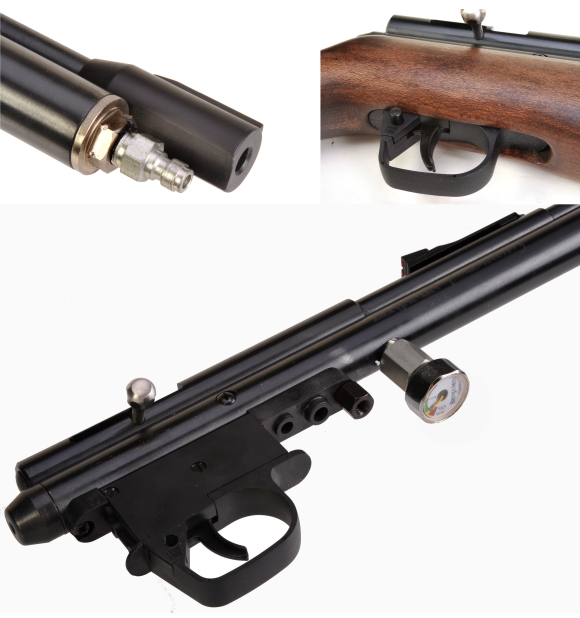
The gun comes apart with removal of the detent spring retained cross bolt safety and one 1/4″ x20 screw that passes through the stock and into an oversize stock lug that is anchored to the gun’s receiver. The fiber filled poly trigger guard, case and cover form good protection for all of the piece parts it contains. Nicely integrated and well thought out design elements. I do not know the gun’s service history, but I would think the Discovery has a good record.
I’m at the age of needing good sights or bigger targets…
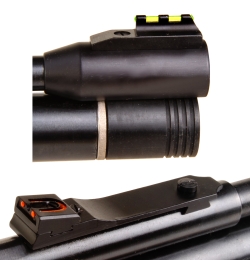
The Benjamin Discovery rifle is supplied with quality fiber optic sights. The rear is fully adjustable for elevation and windage, adjustment stays put once it is set. The sights form a three dot sight picture that is easy to see against bright or shadowed backdrops and they are quick to get on target.
Not a lot of fiddling is required to keep on target with this sight set as shifts in point of impact over the gun’s operating pressure range, or pellet weight range from 4.7 grains to 10.5 grains, are minimal. Groups shift a maximum of 3/4″ as a result of those changes.
I did shoot a few 25 yard groups with open sights. It was nice to see the light pipe diameter was kept to 0.065; plenty of illumination and contrast, but not so large as to obscure a target within legitimate striking distance.
Crosman’s CenterPoint’s Adventure Class 2-7x32mm scope
The CenterPoint Hunting and Outdoors division of Crosman markets a number of shooting accessories, including a range of rifle scopes that would be classify as low to moderate in price; $31 – $200. The scope shown below is manufacturers in China, as is the case with many scope brands these days, and carries an MSRP of $89.99. It is recommended for rifle, shotgun and muzzle loading hunting applications. Because the Benjamin Discovery is not a break barrel, spring piston design, there is no forward recoil in advance of rearward recoil to warrant special air rifle consideration when purchasing a scope.
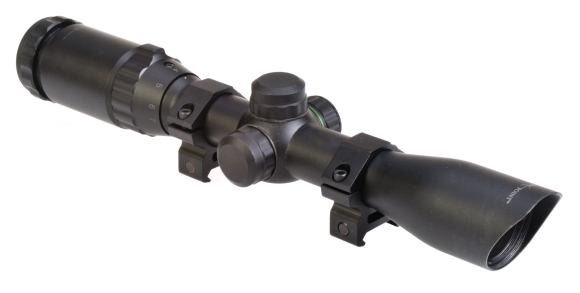
I can’t speak for lens coatings, shock or fog resistance, or method of purging or filling as these details are not provided in product literature or on the CenterPoint site. However, the scope is of one piece tube construction, it is marked as “Torture tested with a .416 Rigby” and it carries a limited lifetime, original owner warranty. The last point, I believe, tells us what is important, the manufacturer stands behind the product.
|
||||||||||||||||||||||||||||
On inspection and in use, the CenterPoint scope was a pleasant surprise. I’m not a price snob. I’ve found some very good inexpensive scopes and I believe this applies to the CenterPoint product. This one even came with cleaning cloth, installation tools, flip up lens covers and Weaver mounts.
Magnification ring movement was smooth, with just enough resistance to retain settings, but not so much that cold weather adjustment would be difficult. With dust caps off, finger setting was positive and point of impact shifts tracked to degree of adjustment. The fast focus feature had more than enough range to compensate for my eyesight.
The scope’s image was… crisp and with good contrast even in bright sunlight, some of which I am sure could be attributed to the objective bell top projection. The entire Mil-Dot reticle is illuminated; red, green or off. Color and brightness are control with a dial on the left side of the scope. Personally, I like the range finding capability of a Mil-Dot Reticle, I use them on my .300 Ultra Mag and .220 Swift rifles and they come in handy for 400+ yard shots. In this case, especially with the illuminated reticle, I think this reticle mostly makes for a fast tracking scope. Not a criticism of this gun, just a fact of pellet rifles, they run out of useful kinetic energy long before trajectory compensation and range assessment get ahead of point blank range.
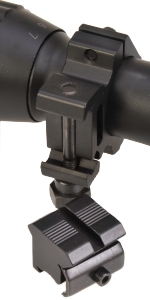
The Benjamin Discovery has an 11mm grooved receiver to accommodate scope mounting, a standard for many conventional rimfire and air powered rifles. The aluminum scope rings supplied with the general purpose CenterPoint scope were Weaver cross slot type, low profile with a 0.400″ saddle height. I’ve listened to the steel versus aluminum mount system debates over the years and have concluded that the steel hardware used to clamp the parts to the rifle are of greater consequence than the actual ring or base material. Considering that aluminum is used to make fuel dragster pistons and landing gear on the worlds largest and heaviest aircraft, I think they can hold a one pound scope in place.
A set of 11mm to Weaver adapters were installed to secured the rings to the gun’s receiver. These pieces also increased the receiver to ring saddle height from 0.400″ to 0.955″. The result was ideal eye – scope alignment and clearance between scope and the gun’s loading port to facilitate easy loading. I set the scope back in it’s mounts. The scope’s eye relief is listed as 5.5″ but effective eye relief at low magnification was closer to 4″ and I have a short neck. I always sympathized with the Neanderthals portrayed in those insurance company commercials.
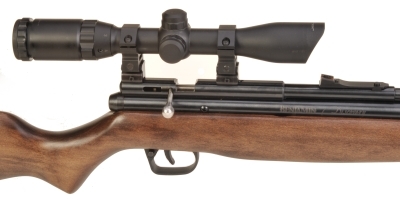
Pellets used, actual size
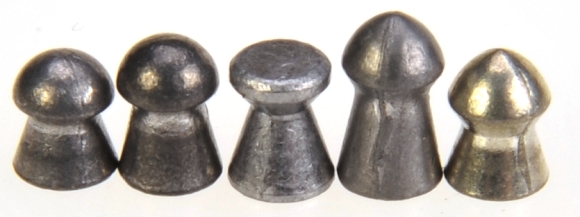
Since customers will shoot a variety of pellet types through their rifles, I do shoot other than same brand ammo in my Winchester and Remington firearms, I thought I would try a handful of brands to see how much performance varied. Of course none proved a problem, but performance did vary.
|
All recorded shots were fired from a freshly charged gun, five shots were fired to determine a straight velocity average. There is no significant difference a amongst this group as there is insufficient mass and to make kinetic energy and issue. In my experience, penetration resulting from pellet construction and shape is of consequence for hunting rather than high velocity, hydrokinetic shock.
I think “slick” isn’t a term that much applies to pellets with the bulk checking in with a ballistic coefficient between 0.010 to 0.030. That’s somewhere between a barn door and an outhouse in terms of slipstream resistance. I don’t think this matters much low projectile sectional density limits the range for any air rifle, even those pushing pellets to 1,500 fps.
10 meters is a standard distance for competitive air rifle shooting, but that is shooting with an objective of making single pellet diameter holes with multiple shots. My interest is in popping pests or small varmints left me with a bit more accuracy latitude. Wet paper penetration tests that were conducted for a prior project suggested that twenty five yards is probably a very safe reliable range limit. So I set up and shot targets at twenty five yards.
Getting on with it…
I was too lazy to dig for the 0.17″ spud for my optical bore sight, and the laser bore sight wouldn’t fit the 0.177″ bore, so I put the rifle in a shooting cradle, aimed at a bullseye and fired a couple of shots to get lead on the paper. 4″ low and 2″ right, I left the gun where it was and walked the cross hairs over to the pellet holes. Then I shot the top right group pictured below and figured that was close enough to collect group size data.
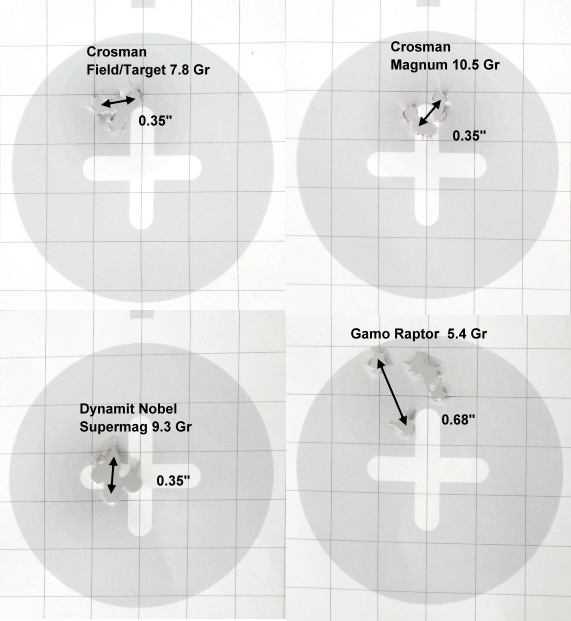
It’s tough to beat the utility and accuracy of Crosman pellets. The Crosman pellets cost a penny to two pennies per shot dependant on type. The Gamo non-lead cost fourteen cents per pellet and they were less accurate. Not on like the ultra high velocity Tin loads for a .22 rimfire. Traditional lead pellets size and conform to rifling more closely and longer pellet skirts seem to foster improved accuracy and they are easier on a gun’s bore.
My final thoughts… at least on this issue

I thought the CenterPoint scope would be el cheapo and I’d have to hold my nose to use it. Far from the truth. The scope was a pleasure to work with, easy to set up and it held through days of heavy usage and rough handling. Where I began not liking the illuminated reticle, it proved to be a good utility for shooting in less than brightly lit Maine woodland.
The Benjamin Discovery was fun to shoot. I began this exercise thinking it would be really annoying to pump the gun up and that I would get only a few shots per charge. I was wrong. Target shooting, small game hunting, forty five shots provides a lot of return on the pump up effort and the performance is ideal for the gun’s purpose.
The open sights are better than what some firearm manufacturers put on their much more costly rifles and they are good sights. The trigger pull is a little heavy, but crisp. The overall fit and finish is good; not an ultra expensive looking gun, but not a cheap looking gun either. Yes, I think it is the kind of air rifle a firearm enthusiast could have around and it would not look out of place. For small game and varmints close is, I think it could be an ideal gun.

Email Notification